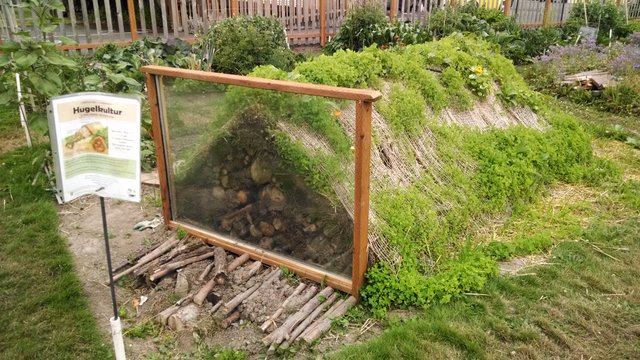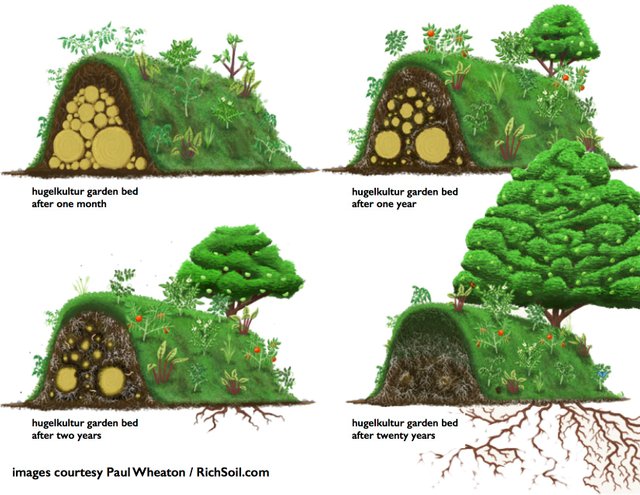Guide to Hugelkulture Raised Beds
Hügelkultur -
German Origin - Pronunciation - (Hoo-gal-culture) "Hill/Mound Culture"

Standard procedure for the mounding of wood is that larger diameter segments of trees should be put at the bottom and get smaller as you build up, eventually ending in light brush/branches. The textbook height af a hugelkulture around 6-7ft tall, although almost any size/height/width will be more fertile than the area around the mound.
Preferable woods:
- Poplar
- Birch
- Apple
- Alder
- Maple
- Oak
Don't use:
- Cherry (toxins/allelopathic)
- Black locust (long decomposition)
- Black walnut (juglone toxin/allelopathic)
- Cedar (anti-fungal)
- Pine (tannins/sap)
This method of long term gardening is great for building up a large portion of fertile soil if your local soil or land is comprised of poor quality soil, too high of alkilinity or low of alkaline soils. Over time (3-5years) the soil is made to better retain water, store nutrients and aerate itself as the mound slowly sinks and decomposes. This method also bring in myriad soil organisms which can transform the immediate vicinity and perhaps help with poor soils around the hugelkultur.
It's said that a decent sized mound (6-7ft) will be fertile for up to two decades, besides being an incredibly laid back style of gardening (apart from the initial building) it is also a way to help save the earth! Burying logs and dead tree debris help sequester carbon into the earth and keep it stored without releasing it into the air as burnt and unburried wood will.
During the first few years the mound will increase the duration (slightly) of your growing season by effectively composting itself and warm up through the process of decomposition. After the first year water will be well retained though the rotted wood which will act as a sponge, along with any mycelium whcih will take hold in the wood as well. One consideration is that the freasher the wood the longer it will take to leach stored nitrogen, older more rotten wood will already be shedding its nitrogen as the C:N (carbon to nitrogen ratio) will be higher. Therefore if one was to hope to see quick returns in nitrogen, one mmight mix fresh and will rotted wood together, or put more rot wood on top to leach the nitrogen the fresh cut will hope to find and in return expidite the process.

For the first year or so consider legumes and other nitrogen fixers/cover crop to fold into the hugelkulture and help boost the nitrogen content. I would stray away from root crops just incase the logs inhibit directional growth (unless you have large layer of topsoil before wood). After the first year most everything is okay to grow!
Benefits:
- Carbon Sequestration.
- Less/No till.
- (Slightly) longer growing seasons.
- Less watering than traditional beds (given no droughts and after the first year).
- If you choose a purely above ground mound it will bea easier on your back.
- Perhaps fewer weeds given the elevation of mound.
- No need to fertilize.
- More food in less space because of increased surface area of mound.
- Retention of water.
- Great for perennials.
- Increase soil organism concentration in/around hugelkultur.
- Can add on/in later.
- Long term food solution in places which have little water or in general poor soils.
Happy Hugel-ing!
Resources:
It is my first time hearing about this topic, and I must say that I am really impressed with all the benefits it gives. These raised beds are a perfect solution for small gardens! Thank you for this lovely post! :)
Thank you! It is an incredible method to use if you know the land on which you live, and will be on the land for more than a few years! Wish I had a picture of the beds I've worked in the past, after the first year its insane how many little insects and worms move into the mound to call it home. I believe this will helpout locally as well with soil improvements and move bio-activity
Hooray! I love the idea of the window to educate with is wonderful!!! Repeating and mimicking nature's patterns and methods is so good.. Great post. resteemed!
Thanks for the resteem, much appreciated! The picture is not mine sadly, that is one classical hugelkultur bed would be so pround to call it my own. Although I do have one, it is excavated. Mines around 4-5 ft deep/height, 4ft wide and 16ft long. This will be added to over time and possibly revised and expanded outward eventually. Following ya!
Thank you for contributing your knowledge to help others! The Sotall Community has linked to your post here.. If you write any future articles with instructions on how to do any tasks related to a homestead or survival, to ensure they are added to the directory, please submit them. They will be added as soon as possible.
Woah! Thank you so much, I'll most definitely keep this in mind for future articles! Much appreciated!
Great picture! What specifically about pine's tannins and sap causes undesirable results? I actually use rotted pine in my seed starting and soil mixes as the base. They rot pretty quickly and extremely spongy. I know Sepp Holzer mainly uses spruce and softwoods in his Hügel beds.
Probably not a massive problem at all, I figure cherry, locusts and walnut are the hypothetical "worst". These either take years to fully decompose ( locusts) or can directly inhibit plant growth (allelopathy with walnut). Pine and other softwood can be useful for acidic loving plants/shuns most notably in my area: blueberry. Pine mulch can help make the soil more acidic if needed.
What I should have done was outline a certain hierarchy, which is hard to classify because of its vague nature:
Well decomposed locust, walnut and cherry are better to use that fresh cut because theoretically they have leached alot of the chemicals/metabolites/structure out of the log. If these woods were among the only ones you had around, they are okay if WELL decomposed. I imagine even if you did use them over time the soil might be more growable as time pases and the certain aspects of the wood wash away. Also you have a very good point with the softwood pine, I almost garentee it would hold substantially more water, more quickly (in the process of decomposition) than other hardwoods would.
I think cedar differs from pine in the way that cedar (along with acidity) has anti-fungal/anti-microbial capabilities.
There, in a sense, is a form of a hierarchy of "preferableness" amonst even these woods.
I guess if I was to have to quickly form a list of overarching woods it would be: (in order of least amount of time for optimum soil quality of hugel)
-Decayed hardwood (quiker nitrogen overall without the wait)
-Fresh hardwood
-Decayed softwood (including cedar)
-Fresh softwood
-Decayed non usables ( locust, black walnut/cherry)
Awesome! Thanks for the details. I usually use what I have available from the brush and rotted wood around my wood lot. I think diversity creates a buffer for any potential risks. But I would agree walnut shouldn’t be used, and black locusts would definitely take years to decompose. Cedar won’t rot either. White oak is so dense it would take some time to break down as well.
Excellent post! Hugelkultur is so interesting.... I did't realize there was wood you should avoid, but it makes sense! Thank you for sharing this knowledge:)
Absolutely! Our purpose as a humans/a community is to help each other get past difficult challenges and learn new ways of doing the new, and/or the same thing (gardening) differently. This is a superior method in places where soil is poor, land is arid, or you stuggle with soils in place that restrict your plant growing choices.
Question you may or may not know the answer to. Would this work build on an incline? The height difference between my driveway and the neighbors yard is a good 5 feet in only about a 10 foot wide area. Most of it is vary hard to mow, and very hard to get anything to grow. I was wondering if I could sort of level it out and be able to grow something there using Hügelkultur?
You could definately level it outwith hugelkulture, keepin mind that over time the mound/hill decreases in size and will "sink in" to a certain extent. It should be able to improve soil quality locally around the area/within the bed, if that is a reason which reduces the ability of plants to grow around the area. If you wish to level it out I would suggest building it taller (flat, if you wish for it to eventually be used for a path/mowable surface) than what would be considered "level" that way you know it will decrease in height, hopefully being areated and eventually, when you want to mow it will hopefully compact to the real height differnce of the drive and your neighbors yard!
Thank you! I am going to cover the whole area in an edible wild flower that prefers the full sun this area gets all day. So sinking some really doesn't matter. It is more for me being able to reach the area without falling down the hill, lol.
I have an endless supply of wood in the form of wholes trees down to large size limbs and about 1/4 of my land is hardwoods that were original when the place was built back in the 80's. I think I will give it a try!